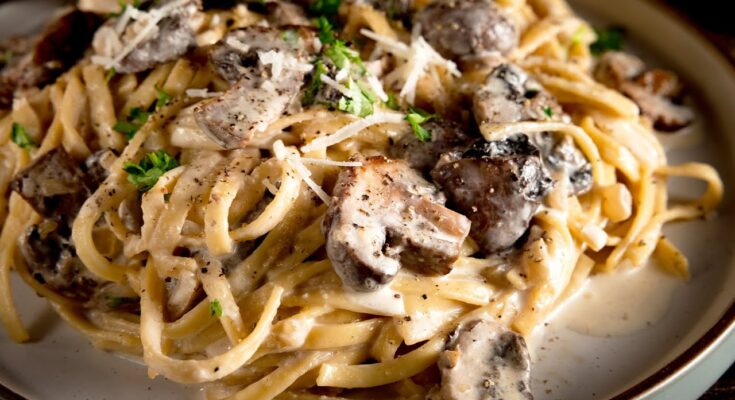Mushroom Pasta Recipe: Let’s be honest—there’s something utterly magical about a good mushroom pasta. It’s warm, comforting, earthy, and creamy without being too rich. Mushroom pasta has become a go-to comfort dish in many households, not just for vegetarians but for anyone who enjoys simple, satisfying flavors that pack a punch. The beautiful thing about this dish is its versatility. Whether you’re whipping it up on a busy weeknight or preparing it for a fancy dinner party, it fits right in.
But what exactly makes mushroom pasta so special? It’s the way mushrooms release their deep, umami-packed flavor when cooked just right. Paired with garlic, fresh herbs, and a splash of cream or broth, the humble mushroom transforms into a culinary rockstar. And when it clings to al dente pasta? Pure magic.
Another reason this dish is so loved is its health appeal. Mushrooms are low in calories and fat but high in nutrients. They’re rich in antioxidants, B vitamins, selenium, and even plant-based protein. So while you’re diving into that plate of creamy pasta goodness, you’re also sneaking in a bunch of good-for-you benefits.
Whether you’re a beginner or a seasoned home cook, this mushroom pasta recipe will guide you step by step to ensure perfection every single time.
Ingredients You’ll Need
Before we even turn on the stove, let’s talk ingredients. The beauty of mushroom pasta lies in its simplicity. But using the right ingredients makes a huge difference in the final flavor.
Essential Ingredients:
- Pasta: Fettuccine, tagliatelle, or linguine works beautifully. But any pasta will do!
- Mushrooms: Cremini, button, or a mix of wild mushrooms like shiitake, oyster, and portobello
- Olive Oil and/or Butter: For sautéing and flavor richness
- Garlic: Freshly minced for that aromatic punch
- Onion or Shallots: Adds depth to the sauce
- Heavy Cream or Plant-Based Alternative: For creaminess
- Vegetable Broth or Pasta Water: To help build the sauce
- Salt and Pepper: Essential seasonings
- Fresh Parsley or Thyme: For garnish and fresh aroma
- Parmesan Cheese (optional): For that final cheesy touch
Optional Add-ins to Elevate the Flavor:
- White wine: A splash helps deglaze the pan and adds complexity
- Chili flakes: If you like a little heat
- Truffle oil or truffle salt: To take the umami up a notch
- Spinach or kale: For added nutrition
- Lemon zest or juice: A touch of brightness to balance the richness
Make sure you prep everything ahead of time—mushrooms cleaned and sliced, garlic minced, pasta water boiling—because once you start cooking, things move fast!
Equipment Checklist
You don’t need a fancy kitchen setup to make amazing mushroom pasta. Here’s a quick checklist of what you’ll need:
Basic Kitchen Tools:
- Large skillet or sauté pan: To cook your mushrooms and sauce
- Large pot: For boiling pasta
- Colander: To drain pasta
- Cutting board & sharp knife: For prepping your ingredients
- Wooden spoon or silicone spatula: To stir without scratching your pans
Handy Extras for Efficiency:
- Microplane or grater: For parmesan cheese and zesting lemon
- Tongs: Helpful for mixing pasta with the sauce
- Measuring cups/spoons: If you’re new to eyeballing quantities
Having the right tools on hand not only makes cooking easier but also helps ensure everything cooks evenly and turns out delicious.
Prepping the Ingredients
Let’s start with the star of the show: mushrooms. Properly cleaning and slicing them is key to getting the most flavor and the best texture.
Cleaning Mushrooms:
- Avoid rinsing mushrooms under running water—they soak it up like a sponge and become soggy.
- Instead, use a damp paper towel to gently wipe off any dirt.
- Trim off the ends of the stems, especially if they feel woody or dry.
Slicing Mushrooms:
- Slice uniformly for even cooking.
- Thicker slices hold their texture better, especially if using delicate varieties like oyster mushrooms.
Prepping Garlic, Onions, and Herbs:
- Finely mince garlic and onions or shallots so they melt into the sauce.
- Chop fresh parsley or thyme just before use for maximum aroma.
Other Ingredients:
- Grate your parmesan cheese ahead of time.
- Measure out your cream, broth, and optional add-ins so everything’s ready when it’s go-time.
Taking a few extra minutes to prep everything ahead ensures your cooking process flows smoothly—and you won’t burn the garlic while scrambling to chop herbs!
How to Make Mushroom Pasta – Step by Step Guide
Alright, now we’re getting into the fun part. This is where the magic happens—layering flavors and textures to create a pasta dish you’ll want to make on repeat.
Step 1: Sautéing the Mushrooms
- Heat a large skillet over medium-high heat.
- Add olive oil and a bit of butter for richness.
- Once the pan is hot, add the mushrooms in a single layer—don’t overcrowd or they’ll steam instead of brown.
- Let them sit untouched for 2–3 minutes to get that golden sear.
- Stir occasionally until mushrooms release their moisture and caramelize (about 8–10 minutes).
- Add garlic, onions, and herbs. Sauté for another 2–3 minutes until fragrant.
This is where the mushrooms become deeply flavorful. That golden sear? It’s non-negotiable.
Step 2: Cooking the Pasta to Perfection
Cooking pasta might seem like a no-brainer, but doing it right makes a big difference—especially when it’s the base of your dish. Here’s how to nail it every time:
- Bring a large pot of water to a rolling boil.
- Add a generous amount of salt (like a tablespoon or more). It should taste like the sea!
- Drop in your pasta and give it a quick stir to prevent sticking.
- Cook until al dente—tender but still with a little bite. This is key because it’ll finish cooking in the sauce later.
- Reserve about 1 cup of pasta water before draining. This starchy liquid is pure gold for adjusting sauce consistency.
Do not rinse the pasta after draining. That starch helps the sauce cling to the noodles like a dream.
Step 3: Creating the Creamy Mushroom Sauce
This is where things get luscious and luxurious. We’re going for a velvety, flavor-packed sauce that hugs every strand of pasta.
- With your sautéed mushrooms still in the pan, lower the heat to medium.
- Deglaze with a splash of white wine (optional but so worth it). Let it simmer until the alcohol cooks off.
- Stir in the cream or dairy-free alternative. Let it bubble gently to thicken slightly.
- Add a splash of the reserved pasta water to loosen the sauce as needed. The starch helps everything emulsify beautifully.
- Taste and season with salt and freshly cracked black pepper. A pinch of chili flakes if you like heat!
If you’re going full indulgence mode, stir in some grated parmesan right into the sauce. It melts in and gives it that cheesy, nutty depth.
Step 4: Combining Pasta and Sauce
Here’s where it all comes together—and timing matters!
- Toss the cooked pasta directly into the skillet with the mushroom sauce.
- Use tongs or a big spoon to toss and coat the pasta evenly.
- Add more pasta water a little at a time if the sauce feels too thick.
- Simmer for another 2–3 minutes so the flavors marry, and the pasta soaks in that creamy goodness.
The result should be a silky, clinging sauce that coats every strand or twist of pasta. This extra minute of tossing ensures everything is warm, flavorful, and ready for plating.
Step 5: Garnishing and Serving
Presentation might be optional for some, but a few thoughtful garnishes can turn your pasta from good to gourmet.
Topping ideas:
- Fresh parsley or thyme: Adds color and a burst of fresh flavor.
- Grated parmesan or pecorino: For richness and saltiness.
- Cracked pepper: That final kick.
- A drizzle of truffle oil or olive oil: Because why not go full luxury?
Plate up your pasta while it’s hot and creamy. Serve it in a shallow bowl with an extra spoonful of sauce on top. If you’re entertaining, garnish with a sprig of fresh herbs and a sprinkle of cheese—it’ll look and taste like restaurant-quality pasta.
Tips and Tricks for the Perfect Mushroom Pasta
Now that you’ve mastered the steps, let’s take it up a notch. These tips will help you troubleshoot common issues and elevate your mushroom pasta to the next level.
1. Don’t crowd the mushrooms
Mushrooms release a lot of water. If you crowd them in the pan, they’ll steam instead of sear. Use a large skillet and cook in batches if needed. This gives you golden, flavorful mushrooms instead of soggy ones.
2. Let mushrooms sit undisturbed
Once they hit the hot pan, resist the urge to stir constantly. Let them brown for a few minutes on one side before flipping. That caramelization adds tons of flavor.
3. Use reserved pasta water wisely
This starchy water is your secret weapon for a smooth, glossy sauce. Add it gradually while mixing the pasta with the sauce to get that perfect creamy texture without over-thinning it.
4. Balance creaminess with acidity
If your sauce feels too rich or heavy, a splash of lemon juice or a few capers can cut through the cream and add brightness. It makes the whole dish feel lighter and more complex.
5. Make it your own
Once you’ve got the base recipe down, experiment with flavors. Add spinach, sun-dried tomatoes, smoked paprika, or even a dollop of pesto. This recipe is super forgiving and totally customizable.
Trust your taste buds, and don’t be afraid to get creative. That’s the beauty of a good pasta dish—it evolves with you.
Variations to Try
One of the best things about mushroom pasta is how easily it can be customized to match your mood, dietary needs, or ingredients you already have on hand. Here are some mouthwatering variations you can try:
Vegan Mushroom Pasta
Ditching dairy? No problem. You can still enjoy a rich and creamy mushroom pasta without any animal products.
- Use olive oil or vegan butter for sautéing.
- Substitute heavy cream with coconut cream, cashew cream, or unsweetened almond milk.
- Add nutritional yeast or vegan parmesan for cheesy flavor.
- Boost umami with a splash of soy sauce or tamari.
The result? A plant-based pasta that’s just as comforting and packed with flavor.
Spicy Mushroom Pasta
For those who love a little heat, spice up your pasta like this:
- Add crushed red chili flakes while sautéing the mushrooms.
- Mix in a bit of hot sauce or chili oil into the final sauce.
- Use spicy sausage or smoked paprika for even more kick (if you’re not vegetarian).
It’s the kind of dish that warms you up from the inside out.
Gluten-Free Option
If you’re avoiding gluten, this recipe can easily be adapted.
- Use gluten-free pasta made from rice, quinoa, or lentils.
- Double-check labels on any broth or seasoning mixes to ensure they’re gluten-free.
The sauce is naturally gluten-free, so you can indulge without worry.
No matter your dietary preferences, mushroom pasta is here for you—cozy, satisfying, and always adaptable.
Suggested Side Dishes and Pairings
Want to make it a full meal? Here are some simple but flavorful pairings that complement mushroom pasta beautifully.
Great Side Dishes:
- Garlic Bread: Crunchy, buttery, garlicky—it’s the ultimate sidekick.
- Simple Green Salad: A mix of arugula or spinach with lemon vinaigrette cuts through the richness.
- Grilled Asparagus or Broccoli: Lightly seasoned veggies balance the creamy pasta.
Perfect Drink Pairings:
- White wine: Try a crisp Pinot Grigio or Chardonnay. Their acidity pairs well with the creaminess.
- Red wine: A light Pinot Noir adds earthiness that complements mushrooms.
- Sparkling water or lemon soda: For a refreshing non-alcoholic option.
If you’re hosting, serve everything family-style. It encourages sharing, second helpings, and lingering at the table—exactly what good meals are meant for.
Storage and Reheating Tips
Got leftovers? Lucky you! Mushroom pasta holds up well when stored and reheated properly.
Storing:
- Let the pasta cool completely.
- Store in an airtight container in the refrigerator.
- It stays fresh for up to 3–4 days.
Avoid leaving it out too long to prevent any bacterial growth.
Reheating:
- On the stovetop: Add a splash of cream, milk, or broth to loosen the sauce. Stir gently over low heat until warmed through.
- In the microwave: Heat in 30-second intervals, stirring in between. Add a bit of liquid to maintain that creamy texture.
Avoid reheating too many times, as it can dry out the pasta and dull the flavors. It’s best enjoyed the next day—if it lasts that long!
Common Mistakes to Avoid
Even the simplest recipes can go sideways if you don’t watch out for a few common pitfalls. Here’s how to keep your mushroom pasta dreamy instead of disappointing:
1. Overcrowding the Pan
We’ve said it before, but it’s worth repeating: if you dump all your mushrooms in at once, they’ll steam, not brown. Always sauté in batches if necessary.
2. Using Wet Mushrooms
Wet mushrooms = soggy texture and lack of browning. Always dry them well before cooking. A damp paper towel does the trick.
3. Overcooking the Pasta
Mushy pasta ruins texture. Pull it off the heat while it’s still slightly firm—remember, it finishes cooking in the sauce.
4. Not Seasoning as You Go
Waiting until the end to season? Big mistake. Layer your flavors as you cook—salt the pasta water, season the mushrooms, and adjust the final sauce to taste.
5. Skipping the Pasta Water
That starchy water is your best friend. It makes the sauce silky and helps everything come together. Always reserve some before draining.
Avoid these errors, and your pasta will turn out beautifully every time—creamy, flavorful, and loaded with mushroom goodness.
Nutritional Information (Approximate)
While the exact nutrition will depend on the ingredients and portion sizes, here’s a rough breakdown per serving (based on a cream-based version with parmesan):
| Nutrient | Amount (per serving) |
|---|---|
| Calories | 450–550 kcal |
| Protein | 12–15 g |
| Carbohydrates | 50–60 g |
| Fats | 20–25 g |
| Fiber | 3–5 g |
| Sodium | 350–450 mg |
To lighten it up, reduce the cream or use a plant-based version. For added protein, toss in some grilled chicken or tofu. Either way, it’s a comforting meal that doesn’t compromise on flavor or nutrition.
FAQs about Mushroom Pasta Recipe
1. What type of mushrooms work best for mushroom pasta?
For mushroom pasta, you can use a variety of mushrooms depending on your flavor preference. Cremini, portobello, and shiitake mushrooms are popular choices for their rich flavors and textures. Feel free to experiment with a mix of wild mushrooms for a more complex taste.
2. Can I make mushroom pasta gluten-free?
Absolutely! To make gluten-free mushroom pasta, simply substitute the regular pasta with your favorite gluten-free variety. Many stores offer options like rice pasta, quinoa pasta, or even lentil pasta that work wonderfully with mushroom sauces.
3. What are some tips for making the creamiest mushroom sauce?
For a creamy mushroom sauce, start by sautéing your mushrooms in butter until they’re golden and all the moisture has evaporated. Add garlic and cook until fragrant. Then, stir in cream and let it simmer until thickened. For an extra creamy texture, add a splash of Parmesan cheese at the end.
4. Is mushroom pasta suitable for vegan diets?
Mushroom pasta can easily be adapted for a vegan diet. Use olive oil instead of butter and opt for plant-based cream alternatives like coconut cream or almond milk. Nutritional yeast or vegan Parmesan can be used in place of traditional cheese to add a cheesy flavor.
5. How can I add protein to my mushroom pasta?
To add protein to your mushroom pasta, consider incorporating ingredients like chicken strips, cooked shrimp, or plant-based proteins such as tofu or tempeh. These can be sautéed and added to the sauce for a hearty meal.
6. Can I prepare mushroom pasta in advance?
Yes, mushroom pasta can be prepared in advance. Cook the pasta and prepare the sauce separately, then cool and store them in the refrigerator. When ready to serve, reheat the sauce, combine with the pasta, and warm through. This helps maintain the best texture and flavor.
7. What herbs and spices complement mushroom pasta?
Herbs such as thyme, parsley, and basil add freshness and complement the earthy tones of the mushrooms. For spices, a pinch of nutmeg or black pepper enhances the flavors without overpowering them.
8. How long does mushroom pasta keep in the refrigerator?
Mushroom pasta can be stored in the refrigerator for up to 3-4 days. Make sure it’s in a sealed container to maintain freshness. Reheat over low heat, adding a little cream or water if the sauce needs thinning.
Conclusion
What makes this dish even more lovable is how versatile and forgiving it is. You can keep it simple with just a few ingredients, or elevate it with gourmet touches like truffle oil or exotic mushroom varieties. You can go full dairy or plant-based, spicy or mellow—it all works.
At the heart of it, mushroom pasta is about balance. It’s creamy but not too heavy, rich but still fresh, and totally satisfying without being complicated. Whether you’re new to cooking or a seasoned home chef, this is a recipe that belongs in your regular rotation. Master it once, and you’ll come back to it again and again.
So go ahead—make it your own, savor every bite, and don’t forget to share. Pasta this good deserves an audience.



